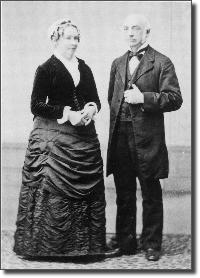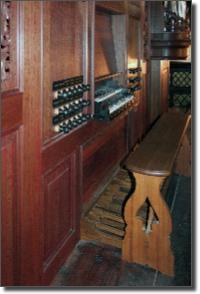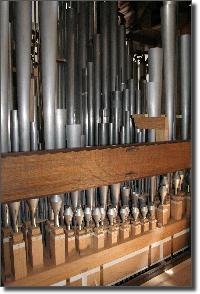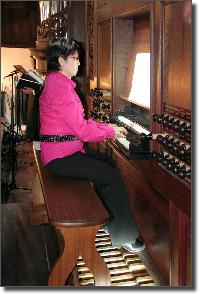 Dr. James C. Hepburn and his wife Clara.
Dr. James C. Hepburn and his wife Clara.
Meiji Gakuin is the name of an accredited school complex known to be one of the oldest Christian schools in Japan.
Meiji Gakuin originated about 150 years ago. In 1859, the first year of the opening of Japanese ports to the International free trade, Dr. James Curtis Hepburn (1815-1911) came to Yokohama as a medical missionary sent by the American Presbyterian Church. He provided free medical care to Japanese people, regardless of their social class and gender. Through his medical practice he would have had plenty of opportunities to learn the Japanese language. He compiled the first extensive Japanese-English and English-Japanese dictionary and he was also closely involved in translating the Bible into Japanese.
In 1863 Dr. Hepburn and his wife Clara opened a small English-language school giving instruction based on Christian values to Japanese boys and girls. It was called the Hebon Juku (Juku is the Japanese word for a small, informal school) and is famous for many excellent students, including the later Prime Minister Korekiyo Takahashi.
After a number of mergers with other Protestant schools, a new educational institution was established in 1886. From that time the name Meiji Gakuin has been applied to the school. Meiji Gakuin at that time was housed at , Tokyo, with school buildings, dormitory and missionaries’ residences. In 1889 Dr. J.C. Hepburn became the first president of Meiji Gakuin.
 Meiji Gakuin Chapel - W.M. Vories, 1916.
Meiji Gakuin Chapel - W.M. Vories, 1916.
Though located in the heart of Tokyo, Meiji Gakuin’s Main Campus escaped damages from the air raids during World War Ⅱ, and with the recovery and development of Japanese society after the war, Meiji Gakuin has grown to a bigger school. Now it has a university with 6 faculties and a law school, two high schools and a junior high school spread over three campuses, Shirokane and Higashimurayama in Tokyo prefecture and Yokohama campus in Kanagawa prefecture. There are now more than 15,000 students at Meiji Gakuin.
The educational principles of Meiji Gakuin are based on the motto of Dr. Hepburn 'Do for others', which is derived from Matthew 7:12: 'Therefore all things whatsoever ye would that men should do to you, do ye even so to them: for this is the law and the prophets'. This motto was the incentive for Dr. Hepburn’s dedication to Japanese society. Meiji Gakuin strives to nurture individuals under this educational principle.
The Shirokane campus in 1887 centered around and . Of the original wooden missionaries’ residences, Imbrie Hall still exists. In 1890 the red brick Memorial Hall was inaugurated and in 1903 followed . After Miller Memorial Chapel was struck by a number of earthquakes, the auditorium on the second floor of Sandham Hall served for a time as chapel. But unfortunately Sandham Hall burned to the ground on 24 November, 1914.
In November, 1915, the first stone for the present chapel was laid; it was built following a design of the American missionary and architect William Merrell Vories. The new chapel was dedicated on 27 March, 1916.
 Meiji Gakuin Chapel with Walcker-orgel from 1966.
Meiji Gakuin Chapel with Walcker-orgel from 1966.
Because of the increasing number of students the chapel was enlarged in 1931 with transepts on both sides, giving it the shape of a cross. From April 2006 until February 2008 the chapel was completely restored, including measures to make the building better resistant to earthquakes.
Services in the chapel of Meiji Gakuin were first accompanied on a large Mason & Hamlin harmonium. In February 1966 a new organ was inaugurated, made by the firm of E.F. Walcker & Co. of Ludwigsburg, Germany.
In 1996 Miho Hasegawa was named organist of Meiji Gakuin Chapel. Miho Hasegawa studied organ at Tokyo National University of Fine Arts and Music with prof. Tsuguo Hirono and prof. Masaaki Suzuki. Later she studied at the Sweelinck Conservatorium in Amsterdam: harpsichord with Anneke Uittenbosch and organ with prof. Dr. Ewald Kooiman and Jacques van Oortmerssen. She also studied at the North German Organ Academy with prof. Harald Vogel.
Meiji Gakuin Chapel with the new organ.
After the appointment of Miho Hasegawa, professor Hirono made up a report on the Walcker organ, from which it was clear that it was in bad condition. Due to the cheap industrial manufacture and the inferior quality it was inadequate to the demands that may reasonably be made of a good organ. Repair would not have made sense.
It was decided to build a new organ according to the highest international standards, with northwest European organs from the second half of the seventeenth and the first half of the eighteenth centuries serving as models. Four organ builders, from Germany, the Netherlands, the USA, and Switzerland, were asked to make proposals.
The chosen plan was that of Henk van Eeken, which proposed an organ of two manuals and 31 stops, with an 8’ Manuaal, an 8’ Rugwerk, and an 8’ Pedaal that would be placed on both sides of the Manuaal. Jacques van Oortmerssen was hired as consultant.
In the course of construction of the organ, Henk van Eeken augmented the disposition with an 8’ Vox Humana on the Manuaal and a 2’ Holfluit on the Pedaal.
This is the final disposition:
Manuaal C-d''' |
Rugwerk C-d''' |
Pedaal C-f' |
||||||||||||||||||
1. |
Prestant |
8' |
doubled treble |
1. |
Prestant |
8' |
doubled treble |
1. |
Prestant |
8' |
||||||||||
2. |
Quintadena |
16' |
2. |
Cornet |
III |
treble |
2. |
Subbas |
16' |
|||||||||||
3. |
Viola di Gamba |
8' |
3. |
Holpijp |
8' |
3. |
Roerquint |
6' |
||||||||||||
4. |
Roerfluit |
8' |
4. |
Octaaf |
4' |
4. |
Octaaf |
4' |
||||||||||||
5. |
Octaaf |
4' |
5. |
Roerfluit |
4' |
5. |
Holfluit |
2' |
||||||||||||
6. |
Gemshoorn |
4' |
6. |
Nasard |
3' |
6. |
Ruispijp |
II |
||||||||||||
7. |
Quint |
3' |
7. |
Superoctaaf |
2' |
7. |
Mixtuur |
IV |
||||||||||||
8. |
Superoctaaf |
2' |
8. |
Nachthoorn |
2' |
8. |
Fagot |
16' |
||||||||||||
9. |
Sexquialter |
II |
9. |
Flageolet |
1 1/2' |
9. |
Trompet |
8' |
||||||||||||
10. |
Mixtuur |
IV-V-VI |
10. |
Mixtuur |
III-IV |
10. |
Trompet |
4' |
||||||||||||
11. |
Trompet |
8' |
11. |
Hautbois |
8' |
|||||||||||||||
12. |
Vox Humana |
8' |
||||||||||||||||||
Click here for the mixture compositions.
Coupler Manuaal to Rugwerk
Coupler Manuaal to Pedaal
Tremulant to the whole organ
Six wedge bellows
Temperament: Kellner-Bach
Pitch: a' = 435 Hertz at 20° Centigrade
Wind pressure: 72 mm water column
The organ was dedicated on 24 October, 2009, with music played by Miho Hasegawa and Jacques van Oortmerssen.
|
|
|


